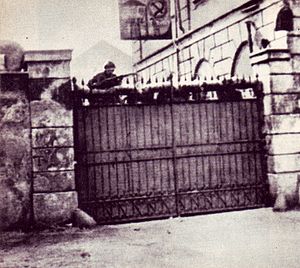Biennio Rosso
| Biennio Rosso | |||
|---|---|---|---|
| Part of the Revolutions of 1917–23 | |||

September 1920: armed workers occupy factories in Milan
|
|||
| Date | 1919-1920 | ||
| Location | Italy | ||
| Causes | The economic crisis in the Aftermath of World War I, with high unemployment and political instability. | ||
| Methods | Mass strikes, worker manifestations as well as self-management experiments through land and factory occupations. | ||
| Result | The revolutionary period was followed by the violent reaction of the Fascist blackshirts militia and eventually by the March on Rome of Benito Mussolini in 1922. | ||
| Parties to the civil conflict | |||
|
|||
![]() Revolutionaries
Revolutionaries
The Biennio Rosso (English: "Red Biennium" or "Two Red Years") was a two-year period, between 1919 and 1920, of intense social conflict in Italy, following the First World War. The revolutionary period was followed by the violent reaction of the Fascist blackshirts militia and eventually by the March on Rome of Benito Mussolini in 1922.
The Biennio Rosso took place in a context of economic crisis at the end of the war, with high unemployment and political instability. It was characterized by mass strikes, worker manifestations as well as self-management experiments through land and factories occupations. Tension had been rising since the final years of the war. Some contemporary observers considered Italy to be on the brink of a revolution by the end of 1918.
The population was confronted with rising inflation and a significant increase in the price of basic goods, in a period that extensive unemployment was aggravated by mass demobilization of the Royal Italian Army at the end of the war. Association to the trade unions, the Italian Socialist Party (PSI), and the anarchist movement increased substantially. The PSI increased its membership to 250,000, and the major Socialist trade union, the General Confederation of Labour (Confederazione Generale del Lavoro, CGL), reached two million members, while the anarchist Italian Syndicalist Union (Unione Sindacale Italiana, USI) reached between 300,000 and 500,000 affiliates. The vigour of the anarchists was boosted by the return from exile of the anarchist leader Errico Malatesta.
...
Wikipedia
